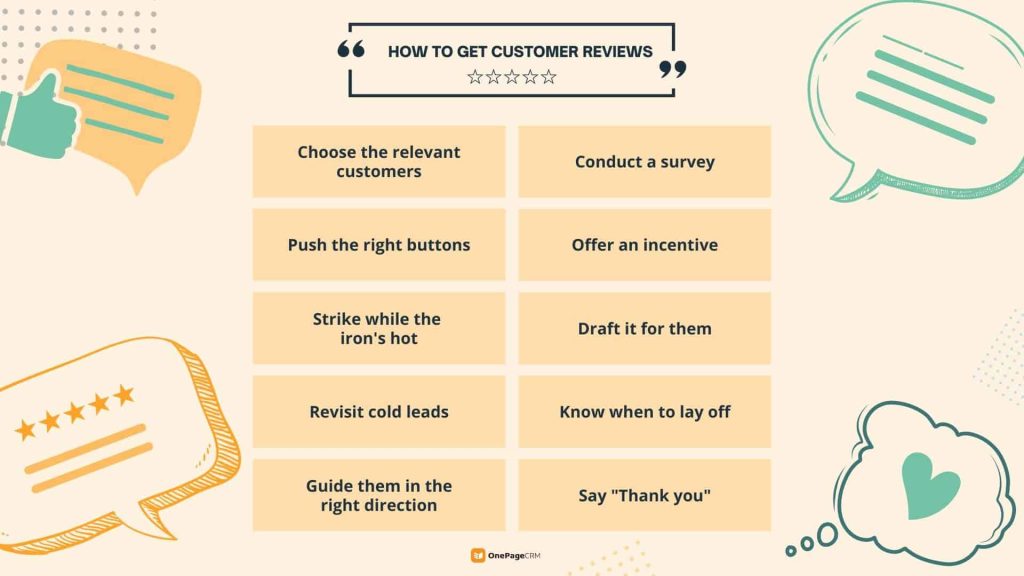
How to get a testimonial from a client (10 effective tactics)

Few, if any, marketing tools carry more clout than a positive testimonial from a satisfied client, yet many businesses struggle to add this tactic to their marketing armory. Getting customer reviews, they’ll tell you, is no easy task.
In this blog post, we compiled 10 tips for getting valuable feedback from your customers.
Why asking for a testimonial from a client is difficult?
The common perception is that customers don’t have time to write glowing reviews about your products or services – they’ve got more important things to do. You’re already grateful that they’ve done business with you; you don’t want to risk tarnishing the relationship by pushing your luck and asking them for more.
Then there’s your time. Chasing customer feedback requires resources – a plan of action, a process, people – to keep it efficient and make sure that all those juicy endorsements get harvested. It takes time and money.
Knowing how to ask is an elusive skill too. The thought of getting it wrong and coming across as a nuisance is enough to prevent a lot of businesses from trying.
The truth, though, is that your customers do have time; in fact, a happy customer enjoys being asked to share their praise, provided you make it easy for them.
How to get customer testimonials: 10 effective techniques
If you need to get feedback from your customer, simply asking might not be enough. You need to put some thought into who is the best person to ask, what questions you want to ask, and how to ask them the right way.
Here are 10 tips for getting customer reviews to build trust, gain authority, and boost your sales.

1. Choose appropriate customers
Obvious as it may sound, you stand a much better chance of getting a positive review from a satisfied customer than you do from one who has had issues with your service. This is worth pointing out because selective targeting will help you get much more value out of your feedback strategy.
Customers who are delighted with what you’ve done for them will be happy to put their praise in writing. Being asked will make them feel a bit special and it’s good exposure for them too. Think about the celebrity reviews you find on the back cover of a book. They say as much about those celebs as they do about the book: they were deemed worthy of asking.
Don’t rule out less satisfied customers, though. Feedback isn’t all about praise, it’s about learning, and there’s no better way to rebuild your relationship with a dissatisfied customer than to ask them what you could have done better. They might even find some words of praise in amongst their criticisms, giving you a really honest, balanced review that will carry real weight.
Above all, seek feedback from customers that are relevant. If you want to drive sales of your washing machines, there’s no point asking for feedback from someone who bought a microwave.
So begin your feedback campaign by:
- deciding what product or service you want to promote first
- and then targeting happy, relevant customers.
2. Push the right buttons
“Making the ask”, as they call it in charity circles, can be daunting. We all fear rejection, especially if it comes from a valued customer who we want to keep sweet. As a general rule, however, people are much happier to be asked than you expect. It’s flattering to be asked, it lets them know that you take customer satisfaction seriously and, as with charity, we all tend to welcome the opportunity to be helpful.
You can help yourself considerably by applying a few fundamental principles.
The first of these is “Make it quick!” Although your customers will be flattered, this doesn’t mean they’re prepared to spend ages working on a review. Whatever method you use to get client testimonials, make sure it can be done in a couple of minutes at the most.
The second principle is “Keep it simple!” This goes hand-in-hand with making it quick. Further down I’ve suggested various methods for getting reviews, all of which are designed to make it as easy as possible for the customer to share feedback.
The third principle is “Ask nicely!” This should go without saying for any feedback request you send. Be polite, grateful, and respect their right to refuse.
3. Strike while the iron’s hot
Timing is everything. If you’ve got a client for whom you’ve just completed a project with great success, don’t let the euphoria go cold before asking for feedback. You don’t want to appear over-eager either, so give it a week or two for the dust to settle and then ask for feedback. Your excellent work will still be fresh in their mind and they’ll be enthusiastic to share their experience with your other customers.
If you don’t already have an after-sales follow-up process then this is your chance to kill two birds with one stone. B2B clients especially will expect an opportunity to provide feedback and this is your opportunity to get those glowing words down in writing.
4. Rekindle cold cases
While it’s best to ask for testimonials before the afterglow wears off, a good feedback strategy can also turn cold cases into hot new leads. Maybe you sold something to a customer two years ago and you haven’t heard from them since. Drop them a line to ask how they’re getting on. Is your product still working? Are they happy with it? Could you do anything to improve it for them?
They’ll appreciate your care and that you haven’t just sold them something and forgotten about them. There may well be more you can do for them and this contact could open up a whole lot of repeat business. And if they are still happy with your product, ask them to put it into words, and hey presto! Another positive testimonial.
5. Give them a steer
Asking for a review may feel like throwing caution to the wind but there are ways in which you can control the outcome.
Your customers will welcome some guidance, so tell them what you want them to talk about. Your expertise? Your attention to detail? Your value for money? Whatever the selling points that you want to promote, feed your client accordingly.
If you’re using a feedback survey, use this principle to choose your questions. In short, ask questions that will produce answers that make the points you want to make about your products or services.
6. Piece it together
So we come to our first method for asking for feedback: the online survey. This ticks the boxes of being quick and simple.
Warm them up with a few yes/no questions or “on a scale of 1 to 5” choices, then ask them to expand a little with some open questions. “What impressed you most”? “What could we do to improve?”
Provided you use their words verbatim and don’t take anything out of context, you can piece together a very workable testimonial from snippets written as open answers in an online feedback form. This works particularly well for B2C businesses.
7. Ask them to write one
B2B businesses tend to have a closer, more personal relationship with their clients and so can afford to ask for more in their surveys. Include space for a testimonial at the end of your feedback form. Your customers will know the sort of thing you’re after because they’ll be seeking reviews from their clients too.
If you think they’ll need extra encouragement to get around to filling in your form, you can offer an incentive. Incentives can range from a link back to their website from yours through to entry into a prize draw. As long as you make it quick and simple and you ask nicely, you’ll find it works almost every time.
8. Write it for them
If asking for a testimonial doesn’t bear fruit, there is another way: write it for them. In fact, it’s often advisable to make this your standard approach if your clients are the type of people who rarely find time to sit at a computer and type.
This method can be a huge time-saver for all concerned. It also means you get the review you want, with all those selling points checked off.
Resist the temptation to go overboard in your praise for yourself but keep to the facts that you think your client would be happy to endorse. Then send it to them with a polite note asking if they’d be happy for you to publish this testimonial in their name. They’ll be glad to have been spared the work.
9. Know when to lay off
This article is designed to persuade you to go harder in your efforts to get customer reviews. However, it’s just as important to recognize when to lay off.
If you’ve got as far as offering to write it for them and they’re still putting up resistance, let it go and move on to someone else. You don’t want to tarnish your relationship over a few words.
Keep building the relationship by helping them to meet their needs and you might well find that their stance softens further down the line and they give you that five-star review.
10. Say thank you
As I’ve mentioned, feedback is a powerful platform for building client relationships. It keeps the conversation going, keeps your business in their mind, makes them feel good about themselves and, when done properly, makes them feel good about you.
Just as asking nicely is crucial, so is showing your appreciation when they deliver, and telling them when and where their testimonial is published.
If you really want to make it memorable, you can send them a thank you gift, such as a voucher; something they weren’t expecting will really augment the feel-good factor.
Why client testimonials matter?
Ask any business what their most important marketing channel is and they’ll all say the same thing: word of mouth.
Whatever you tell prospective customers about your own business, it will never have the impact of what other satisfied customers might tell them about you.
That’s why positive feedback is like gold dust – and why it’s important to have the tools and tactics in place to get great reviews from your customers.

Blog post author
Richard Chalk, Founder and Director, Rison Software Ltd (proprietor of VirtlX.com)
Richard Chalk has over 24 years of experience in the IT industry and has advised companies on the adoption of technology for major change programs. He has run various start-up companies from cradle to acquisition.
Richard has designed a number of robust business platforms that have proven to be sustainable through the changing world. He enjoys employing innovative concepts and ideas ensuring the platforms remain at the forefront of relevant technology.








